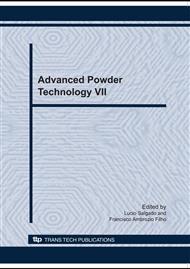p.308
p.317
p.325
p.329
p.335
p.341
p.347
p.353
p.363
The Effect of Mechanical Activation of Elemental Powders on Combustion Synthesis of NbAl3
Abstract:
The effect of mechanical activation procedures on the combustion synthesis of NbAl3 was investigated. The activation was carried out by a two-step high energy ball milling procedure. In the first milling, aluminum and niobium were milled separately (pre-activation). The mixture of pre-activated powders was then activated in the second milling. Reaction synthesis, by simultaneous combustion mode, was conducted on compacted pellets made of powder mixtures with and without pre-activation. The thermal behavior of the compacted pellets upon heating was recorded and the main thermal combustion reaction characteristics were evaluated. The two-step procedure produced aggregates with a globular dispersion of niobium due to increased particle hardness and decreasing mean particle size during pre-activation milling. Analysis of pellet thermal behavior showed the two-step milling procedure could enhance reaction performance by increasing maximum reaction heating rate and temperature gain during reaction.
Info:
Periodical:
Pages:
335-340
Citation:
Online since:
October 2010
Price:
Сopyright:
© 2010 Trans Tech Publications Ltd. All Rights Reserved
Share:
Citation:


